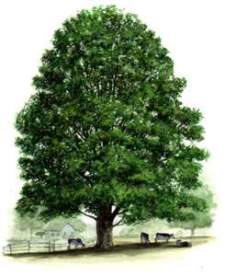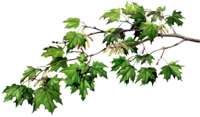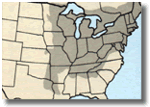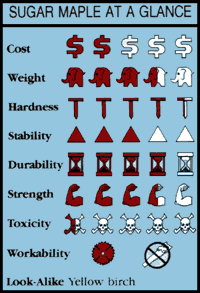Hard as a rock, but how sweet it is!

Acer, part of the maple family’s latin, scientific name, means hard or sharp. And to the Romans, the wood was just that. From it, they made lance and pike shafts for battle. It was furniture, though, that bestowed the term « rock hard » on this traditional stock.

As the story goes, a colonial American cabinetmaker by the name of Rock promoted his work as « Rock’s Hard Maple Furniture. » That’s why to this day many people refer to sugar maple as rock or rock-hard maple.
Sugar maple, although tough as its reputation, has a sweeter side. The other half of its genus name—saccharum—refers to its sap, a source of syrup and sugar.
Wood identification

Practically all states east of the Great Plains boast sugar maple (Acer saccharum), that in a forest setting, grows 70-130′ tall with a diameter of 2-3′. Open-grown trees have shorter trunks with a rounded crown of many branches. All sugar maples when young have a smooth silvery bark that with age turns ash-gray and breaks into unevenly layered flakes or scales.
Sugar maple has palm-sized leaves with five pointed lobes that in the fall call forth brilliant shades of red and orange. In early summer, double-winged keys—the tree’s inedible fruit—emerge.
Straight-grained, fine-textured, hard, strong, and at 44 pounds per cubic foot as heavy as red oak, the wood of sugar maple has high commercial value. Its sapwood, frequently 3-5″thick, appears much lighter in color than the slightly pinkish-tan heartwood. Both are sold.
Some trees produce spectacularly figured wood in curly, fiddleback, quilt, and bird’s-eye.
Uses in woodworking
Known for its toughness and durability, sugar maple takes a pounding as bowling-lane surfaces, bowling pins, school desks, tool handles, and ladder rungs. On a gentler side, it’s sugar maple that becomes much of the furniture we call « Early American. » The wood also shows up as cabinets, countertops, cutting boards, butcher block, and flooring.
Turners find figured sugar maple, particularly burls and intricately colored spalted stock, appealing for bowls. Fiddleback sugar maple has always been popular for the backs of stringed instruments, such as violins.
AvailabiIity

Sugar maple, sold all across the continent, often comes in board lengths of 12′ and widths to 10″. Large dealers may also offer figured wood as well as plain lumber. And, furniture squares, hardwood plywood, and figured veneers are easily obtained.
Machining methods
Sugar maple isn’t dubbed « hard maple » without reason. It dulls cutting edges, yet it chips. And, sugar maple burns more easily from cutting and machining than any other wood. Here’s how to overcome this wood’s pesky traits:
- Feed densely figured wood, such as bird’s-eye, very slowly into the planer, and never plane it exactly to thickness. Leave some for sanding. Otherwise, the grain tears out in pocks. For hand-planing, set the iron at a 15°-20° angle.
- Dense, close-grained sugar maple demands a rip-profile blade with no more than 28 teeth. Sawdust won’t accumulate, causing friction that heats the blade to burn the wood. If tearout occurs, allow for a 1/32″jointing pass to clean the edge.
- Crosscut figured wood with help from a backing board.
- Drill sugar maple at about 250rpm, and back the bit out to clear chips. A stubby, spurred brad-point bit won’t burn the wood as easily as one with long spurs. Burning glazes the wood.
- Avoid burning by routing only with bits that have ballbearing pilots. With speed control, rout slowly. Use a consistent feed rate.
- Lubricate screws.
- Sugar maple doesn’t absorb glue immediately, sometimes resulting in joint slippage from excess glue. If this happens, switch to a glue with longer open time (such as a white glue) and put down a lighter coat. Briefly join the pieces, then pull them apart and let the glue set up before reassembling. Note: Solid joinery usually requires a machined joint.
- Don’t oversand sugar maple with extremely fine paper, such as 400- or 600-grit. Excessive sanding burnishs the wood so that it won’t readily accept stain. Avoid cross-grain sanding. Better yet, use a cabinet scraper.
- For even staining on sugar maple, first apply a wood conditioner, or use aniline dyes. Tinting the topcoat works, too.
Carving comments
- Sugar maple discourages the most accomplished carvers, but it does take very fine detail. Here’s how to handle it:
- Even a shallow gouge bevel of 15°-20° erodes fast in this wood. To add edge longevity, grind a slight (10°) bevel on the backside of the gouge tip.
- Power carvers should start with medium-cut burrs, then follow with finer ones. Coarse-cutting burrs chip the wood.
Turning tips
- Sugar maple turns like a dream, even for beginners, and requires little or no sanding when sheared with sharp tools. Here’s two tips to avoid burning:
- Don’t let the turning tool’s bevel ride in one spot very long.
- When sanding on the lathe, watch for abrasives wearing off. Bare sandpaper running against the wood will burn it, too.
SHOP-TESTED TECHNIQUES THAT ALWAYS WORK

Any exceptions, and special tips pertaining to this issue’s featured wood species, appear under headings elsewhere on this page.
- For stability in use, always work wood with a maximum moisture content of 8 percent.
- Feed straight-grained wood into planer knives at a 90° angle. To avoid tearing, feed wood with figured or twisted grain at a slight angle (about 15°), and take shallow cuts of about 1/32″.
- For clean cuts, rip with a rip-profile blade that has 24-32 teeth. Smooth cross-cutting requires at least a 40-tooth blade.
- Avoid drilling with twist drills. They tend to wander and cause breakout. Use a backing board under the workpiece.
- Drill pilot holes for screws.
- Rout with sharp, preferably carbide-tipped, bits and take shallow passes to avoid burning.
- Carving hardwoods generally means shallow gouge bevels—15° to 20°—and shallow cuts.

